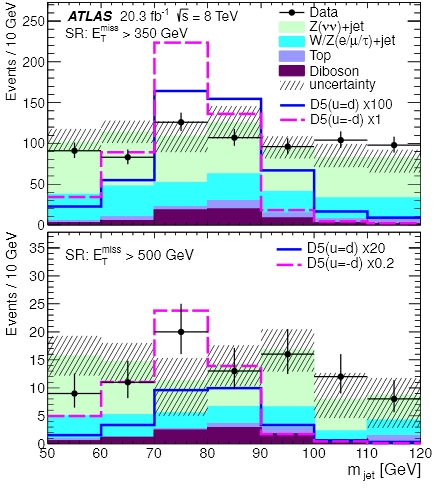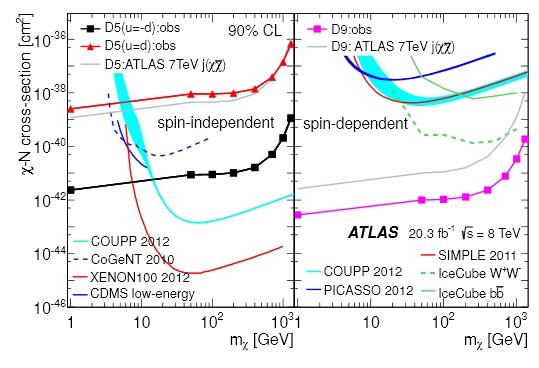ATLAS, like CMS, is a multi-purpose particle detector operating at the CERN Large Hadron Collider (LHC), a facility producing the highest-energy proton-proton collisions achieved so far. In the LHC, protons are accelerated by passing them thousands of times through electrical fields, and their trajectories get curved by extra-strong magnetic fields such that they remain in the correct orbit within the circular accelerator. And then, bam! they get to collide with other protons traveling at the same energy in the opposite direction.
You will notice that I said "at the same energy", not "at the same speed". I could have opted for the latter, but the fact is that once you accelerate a proton by imparting it energy significantly larger than its own rest mass, the proton speed cannot be increased further: it asymptotically reaches the limit of the speed of light in vacuum as you continue to increase its energy. Because of that, physicists brag about their accelerator in terms of how high is the energy it imparts to particles, not the speed - the latter is almost invariably equal to the speed of light, or just short of that by a very, very small margin.
Dark Matter as a particle
Anyway, why would one search for dark matter in the debris produced when protons collide at high energy ? To answer this question we need to first understand what we believe dark matter is made up of, and how we could detect it in other kinds of experiments.
There are very good reasons to believe that dark matter in the universe is constituted by some electrically neutral, heavy particle which was very abundantly produced, together with its antiparticle, during the first instants after the big bang. Once the matter density became low enough that the particle-antiparticle annihilation stopped, the dark matter particles were left free to roam around and fill the observable universe. If these particles are as stable as is for example the proton, they are all still around us 13,5 billion years after they were first produced; and if they do not interact with atomic nuclei via the strong force (the force which holds nuclei together), then there is a chance that we might have been unable to realize so far that these particles are all around us!
If dark matter is made up by these heavy, neutral particles then the Earth, by traveling at 40 kilometers per second should be constantly hit by a wind of these bodies. That is why there are a number of nice, very precisely crafted instruments placed in caverns deep underground which try to detect this wind by observing the recoil of atomic nuclei as the dark matter particles bounce off them (interacting by means of the weak force). These experiments have so far been able only to place limits on the strength of interaction of dark matter with nuclei.
Nuclear recoil experiments are a good idea, but there are other ways to try and solve the mystery. And there is a very big clue we need to consider yet.
Using currently accepted models of the post-big-bang expansion, cosmologists can calculate the number of these dark matter particles that would have been initially produced. This number depends on the interaction properties of the particles, and on their mass. Well, it turns out that a weakly interacting particle with a mass in the 100 GeV range would be present today in abundance exactly matching the fraction of the mass of the universe which we attribute to dark matter. In other words, the hypothesis that dark matter is due to some weakly interacting, neutral particles that are a relic of the big bang leads us to assign them a mass in the 100 GeV range. And 100 GeV is a very special energy - the scale of electroweak symmetry breaking, and the scale of energy where SUSY particles are thought to exist...
A particle with the characteristics described above is a target for the LHC experiments: in proton-proton collisions it should be possible to produce it and observe it. That is what ATLAS has tried to do with the data collected in 2012.
There is a subtlety to consider: a neutral particle which interacts only weakly with nuclear matter, and which is as stable as a proton, cannot be directly observed in a particle detector! That is because it can traverse the detector without leaving a trace, thanks to it weak interaction properties. So we need to resort to indirect detection methods.
Missing ET
The method is based on the quantity called "missing energy", which readers familiar with experimental particle physics should know fairly well. Missing energy is a misnomer: it should be called "missing momentum", to tell the truth; a heavy particle produced in a very energetic collision and recoiling against other particles will be detectable even if it leaves without trace, because we can compute its momentum by subtraction from the momentum of all the other particles we see. In fact, we know that the total momentum (the vectorial sum) of the observed particles produced in a collision should be null in the plane transverse to the beam direction.
To understand what I am talking about, consider two airplanes flying at high speed on a straight collision course: their collision will certainly shatter them and send debris in all directions. If you observed the scene and saw the debris flying out all to the left of the flight paths, you would rightly be surprised: you would reason that since there was no mass in motion along the direction orthogonal to the planes course before the collision, something must be recoiling against the debris to conserve momentum. In other words, something must have pushed in that direction, but there is nothing apparently pushing.
In particle physics you do observe that kind of phenomenon when a neutral particle travels unobserved out of the scene at high momentum, "pushing" all other visible particles in the other direction. By computing the vector sum of the momenta of all observed particles, physicists can infer the presence of the invisible neutral particle.
Note that while in the collision of an electron and a positron, which are point-like particles, one can measure the three-dimensional vector of the missing energy, in hadron collider experiments one must confine to the measurement of the two-dimensional "missing ET" vector in the plane transverse to the beam direction, because system of two partons that produce the collision carry a unknown momentum along the beam.
The ATLAS search
If one hypothesizes the existence of a neutral, weakly-interacting dark matter particle χ, there exist several production mechanisms at a particle collider, depending on the details of the considered model. A common feature is the possibility to create a particle-antiparticle pair of dark-matter, χχ, together with other bodies which recoil against them. If the extra body is a W or Z boson the signature may be quite distinctive. W and Z are the carriers of the weak force, so they might indeed couple to the mysterious new particle; and their decay can be discerned from backgrounds quite effectively.
ATLAS sought for events which contained the signature of a W or Z boson decay into a single, very energetic and fat jet. The jet, if seen recoiling against "nothing" (missing energy in the plane transverse to the beams direction, or "missing transverse energy") might well be all that one can see when dark matter is produced in a proton-proton collision.
The selection of events with a energetic jet recoiling against large missing energy is not difficult; what is difficult is to make sure that the jet is compatible with the decay of a W or Z boson into a pair of energetic quarks. If the boson has large momentum, recoiling against the pair of dark matter particles χχ, then the two quarks will create two narrow streams of hadrons that will all together appear as a single fat jet in the detector. In recent years, the reconstruction of these "sub-jets" has improved dramatically, such that nowadays high-boost W and Z bosons are detected as single fat jets in a way quite competitive to their standard and clean leptonic decay.
 On the right is a graph showing the invariant mass of two "sub-jets" for the selected data in the ATLAS search, and the corresponding distribution that would be expected if two dark matter particles were produced with a W or Z and contributed to the sample (in blue or pink for two different models of the coupling of dark matter to up and down quarks). The two signals have very different size since they correspond to constructive or destructive interference, respectively.
On the right is a graph showing the invariant mass of two "sub-jets" for the selected data in the ATLAS search, and the corresponding distribution that would be expected if two dark matter particles were produced with a W or Z and contributed to the sample (in blue or pink for two different models of the coupling of dark matter to up and down quarks). The two signals have very different size since they correspond to constructive or destructive interference, respectively.The data closely follow background predictions (where backgrounds mainly originate from vector boson plus jet production, where the jet is mistaken for a two-sub-jet system or when it is a regular quark or gluon jet recoiling against a Z boson which decays to two neutrinos; in the latter case the neutrinos play the part of the χ particles, giving the same "missing energy" signature.
The resulting limit on the rate of dark matter particle production can be translated into an upper limit on the cross section of the χ with nucleons as a function of the particle mass. This is shown in the figure below, where in the spin-dependent case ATLAS is seen to produce limits that are more stringent than those of direct searches in underground recoil experiments.




Comments